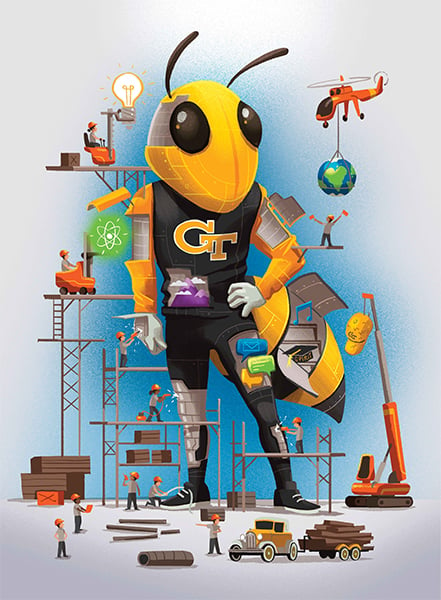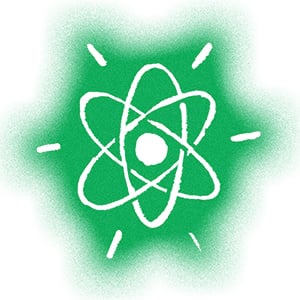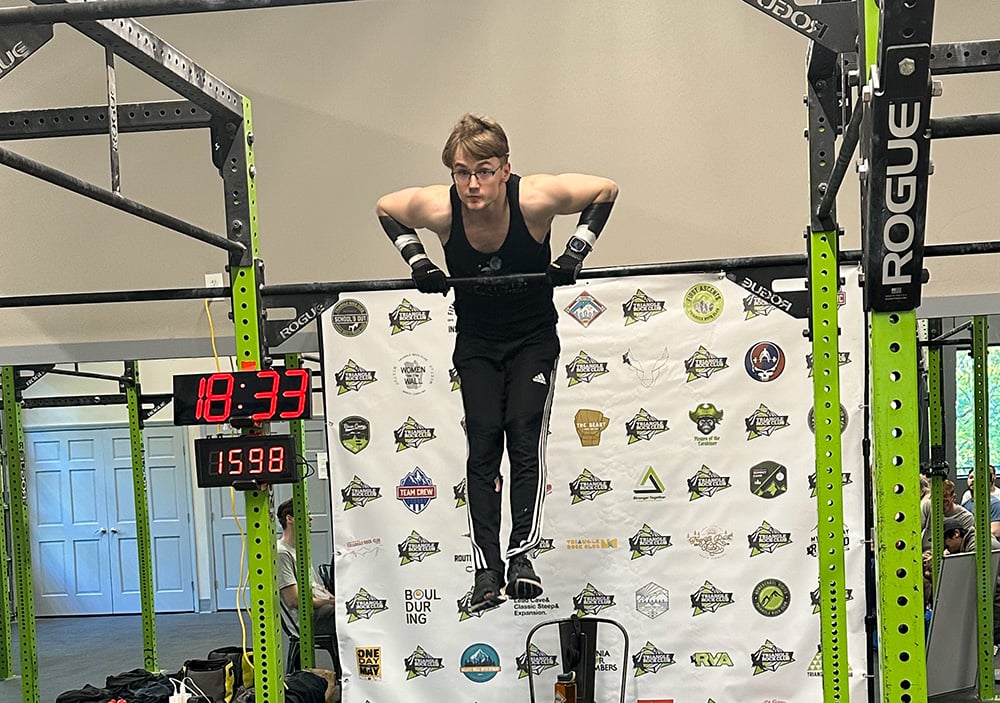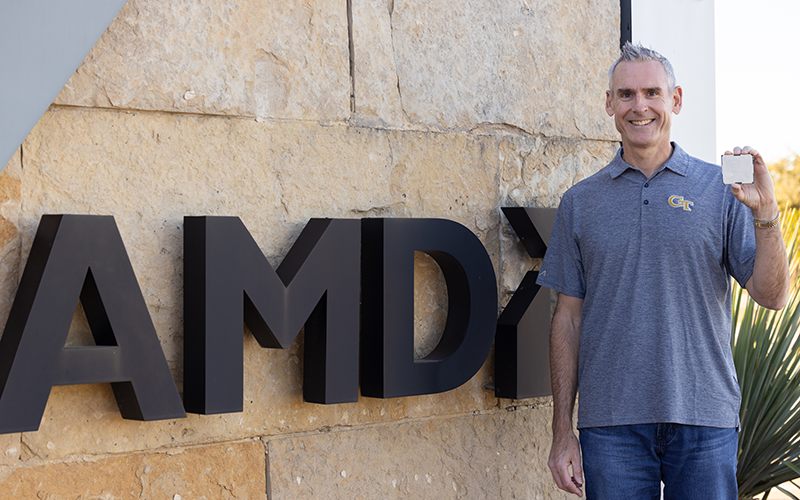How to Build a Yellow Jacket
By: Erin Peterson | Categories: Alumni Achievements

RAW MATERIAL 1: DRIVE
Georgia Tech Provost Rafael L. Bras believes that one of the most powerful traits nurtured in the Yellow Jacket community is the desire not to shy away from challenges, but to charge straight toward them. “Georgia Tech’s programs push our students to be transformative in their thinking—not to just be problem-solvers, but to be problem-seekers,” he says.

The Georgia Tech motto of “Progress and Service” leads to exceptional contributions on an individual level as well. Director of Graduate Studies Marla Bruner says that she’s constantly wowed by the progress she sees students in graduate programs make toward solving real-world problems. In recent months, bioengineering PhD candidate Monica McNerney developed a simpler test to detect deadly zinc deficiencies, while another doctoral student, Jingting Yao, zeroed in on building a non-invasive technique to help detect heart disease. Recent School of Public Policy alumna Jenna McGrath, PhD PP 18, published research showing that simple concrete barriers were more effective at protecting the U.S. grid infrastructure from physical attacks than high-tech alternatives. All their work is designed to help make the world safer—and the people in it healthier.
“We’re intentional about bringing students with a service and progress mindset to campus and cultivating a space for them to utilize their talents,” Bruner says. “The goal is to create a community of scholars who can take the knowledge and experiences they have attained here and apply them in ways that have positive impacts on
society as a whole.”
RAW MATERIAL 2: IRREVERENCE
Despite — and some might say because of — Georgia Tech’s relentless academic demands, students have always found ways to use their innate, quirky sense of humor to deflect stress and blow off a little steam. You can count on Yellow Jackets to come up with more cleverly creative, often irreverent, ways to spend their down time.

While the traffic-snarling parades on Peachtree Street have since been curtailed, Somers says plenty of other recent tinged-with-absurdity traditions have taken hold.
The first warm day in spring, the Campanile pool is quietly filled with plastic water toys and rubber ducks (and a few swimmers, too). The statue of beloved Dean George C. Griffin is often seen with a cap, scarf or flowers of the season in his pocket. A toy tricycle race, the Mini 500, is still held during Homecoming, with teams competing to finish between 10 and 15 laps around Peters Parking Deck. Since 1998, the Goldfellas, a group of Georgia Tech football super fans, have donned yellow wigs, paint, and glitter to cheer at every home game.
And that’s just the start of the hijinks and the multitude of humorous traditions that have been passed down over the years.
Tech students haven’t always kept their irreverence within campus boundaries: In 2014, when Tech’s football team played their archrival, a Tech student—Ryan Pickren, CmpE 17—hacked into the University of Georgia’s computer system to add “Get A** Kicked by GT” to its calendars. At the time, The Atlanta Journal-Constitution noted that some called it “the greatest prank ever” between the institutions.
Law enforcement officials were less enthusiastic. But the student sidestepped a felony charge in return for community service. In true Tech fashion, Pickren eventually put his considerable hacking abilities to good use—he helped United Airlines find weaknesses in its systems, then donated the 5 million miles he earned in the process to Georgia Tech student organizations.
RAW MATERIAL 3: INVENTIVENESS
If you can dream it, you can probably build it at Georgia Tech. College of Engineering Dean Steve McLaughlin and Executive Vice President of Research Chaouki Abdallah, MS EE 82, PhD EE 88, teamed up to share insights about how Tech gives students the tools to breathe life into their cutting-edge ideas.

Abdallah: Our goal is to instill the research skills and the entrepreneurial confidence in our students through courses, student competitions and spaces for design.
McLaughlin: Georgia Tech is also home to the nation’s largest undergraduate invention competition: the InVenture Prize. Nicknamed “American Idol for Nerds,” the InVenture Prize at Georgia Tech is an interdisciplinary innovation competition open to all undergraduate students and recent graduates of the Georgia Institute of Technology. A number of teams that have participated in the competition have spun their ideas off into successful companies. The InVenture Prize model has been so successful on campus that it spawned a competition among Atlantic Coast Conference (ACC) schools, as well as a burgeoning participation from middle and high schools in Georgia the K-12 InVenture Challenge.
Abdallah: In short, our students come to Tech with the raw material to succeed, and Tech helps them turn their potential into engineering marvels.
RAW MATERIAL 4: GRIT
When a Yellow Jacket gets knocked down, you can be sure of one thing: They’ll get right back up again. Some call it tenacity, others call it grit, but it might just be the single most important trait among Tech students and alumni.

To be sure, Georgia Tech was designed to be tough from the very beginning—only 20 percent of the institution’s earliest students made it three months into their academic program, let alone all the way to graduation. Former Institute President Isaac Hopkins famously had to create a probationary school on campus to help applicants adjust to the school’s grueling academics.
Even today, students refer to commencement as “getting out” rather than “graduation”—a nod to the resolve it takes to make it through the Institute’s academic gauntlet. “Not everyone has the will and determination to stay,” says business student Cici Calhoun. “Tech challenges you, teaches you about yourself, and pushes you outside of your comfort zone. That pays off in the end.”
RAW MATERIAL 5: CURIOSITY
Whether they’re building a robot to navigate the real world or an app to navigate a virtual one, Yellow Jackets bring a host of technical skills to bear to any project. And they know that before getting there, they’ll have to build a prototype or two at first, or work tirelessly to craft flawless code.

It’s not just in the lab that students’ inquisitiveness is essential. Scheller College of Business’s Jacqueline Garner, named one of the country’s best undergraduate business professors by Poets & Quants, uses a single word to describe her favorite students—curious.
“So many students come to me with ideas,” Garner says. “They’re very engaged in their own education, and that makes them a joy to be around.”
Students’ desire to understand the world around them, says Sivakumar, is what leads to breakthroughs. When one CREATE-X company launched, he says, they were laser focused on creating a better version of Google Maps with augmented reality. But their deep research— including hundreds of miles of drive-alongs—led them to a surprising discovery: The foundation of their work might be better suited to support package deliveries.
Now the company, LogiSight, is moving full speed ahead on solving this new problem. “This kind of adaptability is not possible without having the innate curiosity to find a genuinely important problem,” Sivakumar says.
From fostering the Tech network to providing scholarships for tomorrow’s students, Yellow Jacket couple Jimmy Mitchell, CE 05, and Angela Dobson Mitchell, PTCH 04, share how the Georgia Tech community pays dividends for a lifetime.

Angela: I got my co-op job with Kimberly-Clark because I attended the info session and spoke with an alumnus of the Textile School. He got me an interview, which turned into the co-op job, which led to my full-time employment.
Jimmy: Angela and I endowed a scholarship shortly after graduating. Our current scholar has an internship with the design firm developing 3-D solar panels on the International Space Station. We are on our third generation of scholarship recipients, and they are all incredible people.
Angela: We love helping each generation of Yellow Jackets. Georgia Tech is my home, as much as my hometown is, and the GT community is my family. I believe the strength of the Tech experience is the progress and service that the community provides, both internally and externally. Georgia Tech’s can-do culture creates Yellow Jackets that are out there to solve the world’s problems.


